
Best of Mexico
US Border to
Lake Chapala
Published, 2000
"The climate is exceptionally agreeable, yet difficult to describe. If one can conceive the delights of a crisp day in October, united to the brightness of a clear day in January, but without snow or ice, and, mingled with these, the lifegiving air of a balmy day in May, and then imagine twelve months of such weather, some idea may be had of this enchanting clime."
Fanny Gooch, 1887
October 1999
Lake Chapala
Jalisco, Mexico
Lorena and I have finally returned to Mexico and are living on the shore of Lake Chapala, the country’s largest lake, about 45 minutes by freeway from Guadalajara. This region has long been a magnet for gringo “snowbirds” and expatriates, and thousands of Americans and Canadians live here, either year ‘round or part-time. It is easy to understand why: the quick access to Guadalajara (a city of millions), moderate elevation, near-idyllic climate and the beautiful lake make a rather irresistable combination.
We chose Lake Chapala this winter for several reasons. First of all, unlike other places we’ve lived recently, such as San Miguel de Allende and Cuernavaca, the lakeside is well situated as a base for exploratory sidetrips in virtually every direction. Thanks to Mexico’s expanding freeway system (perhaps more accurately called a “tollway system”) we can drive safely and comfortably to the highland lakes of Michoacan or our favorite Pacific beaches in a matter of hours. Back in the “good old days” of two-lane highways and bumper-to-bumper belching trucks, such outings were grueling all-day-or-more adventures (sometimes known as “ordeals”).
A second major attraction for us is Lake Chapala’s nearly postcard-perfect climate. To put it bluntly, I’ve had more than enough of the cold, monotonous drenchings we suffer almost year ‘round in the Great Pacific North-Wet. When we arrived here in early September, the temperature was in the low-to-mid 80s during the day, and low-to-mid 60s at night. In the past few weeks, these benevolent temperatures have varied by only a few degrees.
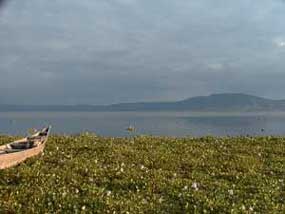
September and October are the end of the summer rainy season here, so we’ve enjoyed an occasional late-evening shower, with dramatic clouds, lightning shows and wind squalls.
Needless to say, I’ve been wearing shorts, t-shirt and sandals since the day we arrived, instead of my standard uniform of long-johns, duck boots and dripping scowl.
We also came to this area to continue research for our book-in-progress on retiring and living in Mexico. During the winter months, the communities along the lake overflow with snowbird gringos. With some trepidation, we decided to dive right into our work by renting a house virtually in the middle of this 'scene'.
The main questions we hope to answer here are: does Lake Chapala actually offer the fabled “Good Life” that so many expatriates yearn to enjoy south of the border? And if not, why are there so darned many real estate agencies around here?
Well, our first impression is that compared to our cabin life back in the States, with outhouse, woodstoves and generator to tend, we’re now living in the lap of semi-luxury. For $330 a month we have two large bedrooms, 2 baths, spacious living-dining area, kitchen, telephone and (unused) television cable. Better yet, a muscular, square-shouldered woman named Ester comes in twice a week and vigorously swamps the place out for us.
The house is very plain inside, but it is also bright, cheerful, well-lighted and freshly painted. The furniture is Mexican Inquisition: frighteningly ugly and remarkably uncomfortable, but then again, furniture has never been one of our priorities. The house does boast two eye-catching pieces: a round, mustard-colored table padded with imitation Naugahyde and a truly massive mahogany & brass mirrored sideboard. The caretaker swears that this awesome relic once displayed Pancho Villa’s personal arsenal. Did I mention that it is illuminated with blue light bulbs?
Our trip from Washington to Ajijic was fast, hot and very tiring. I was scheduled to lead a trek in the Copper Canyon in mid-October (since cancelled), so I wanted to get settled in Ajijic as soon as possible. This meant that our usual west coast visits with family & friends were quite limited: we spent one night in Deadwood, Oregon with Tina Rosa and two nights with Lorena’s mother Marion in (beautiful) Yuba City. Alas, this hurried schedule did not allow time to make our traditional pilgrimmages with Marion to admire the Sutter Buttes (World’s Smallest Mountain Range!) or the earthen dam at Orville.
After a fantastic lunch in Lodi with Lorena’s Aunt Unie and Aunt Juanita --including Unie’s homemade and dangerously delicious peach pie with ice cream -- we continued west into Arizona. With little to distract us, we drove quite late that night, eventually pulling into a rest area somewhere in the middle of nowhere for a few hours of sleep. The next "high" in our journey came the next afternoon near Phoenix, where the thermometer pegged at 108 degrees Farenheit.
Our last stop was just north of the U.S./Mexico border in Patagonia, Arizona, to overnight with our friend Carol Delattre. To our surprise Patagonia is in hill country, and was surprisingly green. The night-time temperature was also in the much more pleasant 70s, so we had a good rest.
We crossed into Mexico at Nogales, just after noon in mid-September. The formalities were brief and matter-of-fact: for $15 you now get a multiple entry 180 day tourist visa. (You actually pay the $15 fee later, at virtually any bank inside Mexico. This must be done before you leave the country.)
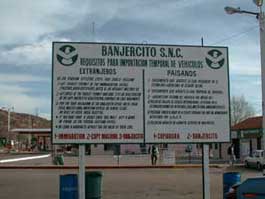
A large sign at the immigration parking lot (south of the border, at Kilometer 23) gives detailed instructions on the steps for getting your tourist visa and vehicle import permit.
Lorena took out the import permit for our van in her name. Again, it was just a standard bureaucratic paper shuffle, quite unlike the stressful hassles and bribe-giving we used to endure at the border.
Thanks to a relatively smooth four-lane divided highway, we reached San Carlos Bay by early evening. San Carlos is a popular gringo enclave on the Gulf of California, just north of Guaymas. This is the thorny western edge of the Sonoran Desert, with lots of cactus, rocks and irritable snakes. To put it politely, summers here are fierce. We passed several large RV parks, but weren’t surprised to find them utterly deserted. By December, however, fleets of American and Canadian road-retirees will crowd the place from wheel-to-wheel.
Continuing north past the marinas, dive shops, mini-marts and real estate offices, we eventually came to the Club Med and the end of the paved road. After bouncing along for a few more minutes on a rough dirt track that parallels the beach, we finally parked on a littered but otherwise empty beach, just in time for the sunset.
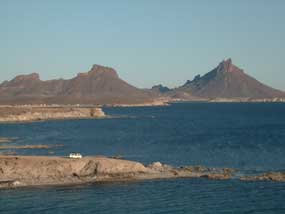
Our VW van parked out by the old "Palalpa"
Other than a moth the size of a pelican that insisted on landing on us while we were meditating, the evening was relaxed and uneventful. Dinner was a box of crackers and a can of smoked Alaskan salmon, lubricated with tofu mayonnaise and jalapeño peppers. With nothing else to distract us, it was time to go to bed....
We’d been on the road for about a week, so to a casual observer the conditions inside our van might have appeared seriously chaotic. In addition to all of my Copper Canyon trekking gear, we had our usual piles and boxes of clothing, Lorena’s winter quilt collection, her personal bookcase, two laptop computers with related manuals, cables, hardware and software; a scanner, a friend’s desktop computer CPU and attachments, several boxes of files and vital papers, cameras and kitchen utensils, plus enough snacks, vitamins, supplements, packaged tofu and organic popcorn to sustain us well into Y2K.
The bed that theoretically makes the van a “camper” was buried somewhere under this stuff. In order to actually get into bed, much of this cargo had to be moved and repacked -- into, around, and beneath the front seats. Thanks to almost ten years of serious meditation practice, however, we were able to accomplish this gruesome task with a minimum exchange of elbows and insults.
At bedtime the temperature was still near 90 degrees and quite humid. After a “spit bath”, we found some relief from the heat in a brisk onshore breeze that allowed us to sleep under a sheet with the doors wide open. (By early morning, the temperature had “plunged” just one degree.)
The next day was a textbook example of how travel in Mexico has changed in recent years: after doing email and breakfast at the Cafe de Internet in San Carlos, we drove a record-breaking 550 miles in less than twelve hours. We also accomplished this feat without a single hot flash of terror or near-death highway experience. Travelers who gripe about Mexico's expensive tollways just don't have a clue to what this journey was like back in the "good old days".
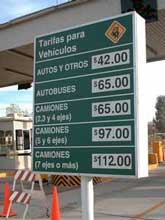
Our total for tolls from the border at Nogales to Guadaljara was 711 pesos ($78 at 9.1 pesos exchange rate). (From Nogales to Mazatlan 466p, Tepic to Guadalajara 245p)
Unfortunately, the wonderful, divided Maxi Pista abruptly comes to a rough end in Mazatlan, where it turns into very traditional two-lane. Our destination for the day was yet farther south, a hotel in the town of El Rosario.
After stopping to stretch and scrape moths off the windshield, we broke the Golden Rule and continued driving after dark. Our marathon concluded with a tense hour of chuckholes, bumper-to-bumper semis and speed-freaks passing on blind curves.
The Hotel Yauca is a small, family-run establishment on the southern edge of Rosario. The hotel is comfortable, immaculate and cheap ($22 with air/c or fan, and TV). There is also an excellent restaurant beside a large, inviting swimming pool. We passed on swimming, and after a very good dinner and meditation, Lorena and I both fell into a deep, restful coma that lasted until well after dawn.
The next day began with another 3 1/2 hours of hectic two-lane. The northern half of this highway has some very bad sections, with traffic sometimes slowed to less than 5 mph. Once you get past those obstacles, however, it becomes quite good, with broad shoulders and virtually no potholes. We easily did 65 mph without hazard. Once we reached the four-lane Tepic freeway, we were in the clear.
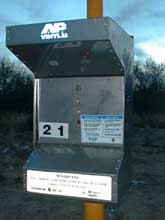
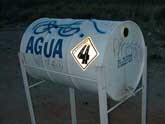
Emergency phones and water are located every few miles along the tollroads. We noticed that in the dry north, however, many of the water drums are empty.
By the time we reached Tepic, we’d made such good time that we actually needed to back off a bit. Our friends expected us for dinner, so there was no point in arriving in mid-afternoon. The best way to slow down was obviously to treat ourselves to a very long lunch at Arturo’s, a wonderful seafood restaurant in Tepic. Arturo’s makes an especially mouth-watering dish called "pescado sarandeado". Ours was a entire robalo (snook; a "five star" fish however it is prepared), butterflied, basted with a special sauce, then grilled very slowly over wood coals. It took an hour to prepare the fish, so we entertained ourselves with smoked marlin empanadas and a special, smoky bean taco appetizer.
Aside from the blaring of several televisions variously tuned to the "soaps", Mexico City news, American beisbol, and children's cartoons, it was a perfect meal -- and cost about $13, including a generous tip.
In spite of our big lunch, once we got back on the road it was easy to stay alert: the highway between Tepic and Guadalajara is one of the most scenic in Mexico. It is especially beautiful in autumn, when the cornfields, canyons, and ancient lava flows are suffused with a soft, golden light.
Once we'd arrived at Lake Chapala and had a good night's rest at our friends, David and Dona's, the fatigue of the past few months really caught up with us. Emptying the van into our new house the next morning was our last gasp for several days. Once the last box had been unloaded, Lorena dropped onto the bed and flashed me a "do not disturb" sign as obvious as a billboard.
Lorena's note: Carl and I are no longer living in the Lake Chapala area, but have returned to our cabin in northern Washington state to be nearer our mothers. However, we continue to return to Mexico at every opportunity.
Best of Mexico
The Globos
Our Favorite Lake Chapala Book
Chapala Websites
Top of Page
|
|||||||||||||||||||
|
|||||||||||||||||||